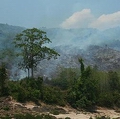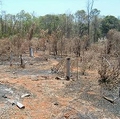 一個奧地利、巴西及美國研究合作團隊所發現的新研究成果顯示,富裕國家可透過付錢給開發中國家的地主,協助減少全球溫室氣體排放,以免他們為了農業進行林地整伐。
一個奧地利、巴西及美國研究合作團隊所發現的新研究成果顯示,富裕國家可透過付錢給開發中國家的地主,協助減少全球溫室氣體排放,以免他們為了農業進行林地整伐。
這項研究提供減少每一公噸碳的成本美元預估值,這些成本可以透過避免非洲、中南美洲及東南亞的森林被砍伐而被省下來。
許多政府每年願意花費總計10億美元來防止未來25年間每年大約5億公噸的二氧化碳溫室氣體排放量。
研究團隊表示,停止砍伐全球大約1/10熱帶森林將需要大約同樣數量的金錢。熱帶地區去森林化過程中砍伐及燃燒樹林,將土地轉變來種植穀物及畜養牲畜,大約會製造全球整體人為碳排放量的1/5。
這項研究估計,如果這項建議被採納了,這樣的方案將可能降低2-10%全球碳排放量。
這個計算結果是一群科學家及經濟學家發表在7月23日美國「國家科學研究院學報(Proceedings of the National Academy of Sciences)」電子版的幾個預估值之一。
這項研究成果的共同作者,也就是俄亥俄州立大學(Ohio State University)農業環境及開發經濟學系教授桑正(Brent Sohngen)表示,根據這些預估數據,用來買碳額度的整體成本將比已開發國家所預期要花在以規範工業、運輸及能源產業方式減碳的成本還要低。
這些根據3個不同的林業與土地使用模式的計算值,提供迄今為止最好的減碳成本預估,這些預估值是用來計算已開發國家要參與名為「免除森林砍伐(avoided deforestation)」全球減碳計畫中所要付出的成本。
發展3個預估值計算模式之一的桑正表示:「比起其他方式,免除森林砍伐計畫對美國而言相對來講更便宜務實,這將為美國納稅人省錢,同時提供從地球上一個地區將大量資金轉移至另一個地區的方法,使開發中國家在全球經濟大餅中也能分得一大塊,用在他們想用的地方」。
 這三個用來計算預估價值的模式包括由桑正所開發的「全球林木模式(the Global Timber Model)」、在奧地利盧森堡國際應用系統分析研究所(International Institute of Applied Systems Analysis)開發的「林業與土地替代利用動態整合模式(the Dynamic Integrated Model of Forestry and Alternative Land Use)」、以及加州勞倫斯柏克萊國家實驗室(Lawrence Berkeley National Laboratory in California)所開發的「廣用性全方位減緩評估程序模式(the Generalized Comprehensive Mitigation Assessment Process Model)」。
這三個用來計算預估價值的模式包括由桑正所開發的「全球林木模式(the Global Timber Model)」、在奧地利盧森堡國際應用系統分析研究所(International Institute of Applied Systems Analysis)開發的「林業與土地替代利用動態整合模式(the Dynamic Integrated Model of Forestry and Alternative Land Use)」、以及加州勞倫斯柏克萊國家實驗室(Lawrence Berkeley National Laboratory in California)所開發的「廣用性全方位減緩評估程序模式(the Generalized Comprehensive Mitigation Assessment Process Model)」。
這些模式採用不同的經濟學及生物學假設來達成他們對森林砍伐及碳排放的透視剖析。每一個模式將一段時間內預期的改變納入計算,尤其是那些因人口、收入及技術改變而與農業用土地需求有關的森林砍伐誘因都被納入考慮。
Wealthy nations could help reduce greenhouse gas emissions globally by paying landowners in developing nations not to clear forested land for agriculture, finds a new study by a research team from Austria, Brazil and the United States.
The research attaches estimated dollar amounts to each metric ton of carbon that could be saved through avoided deforestation in Africa, Central and South America, and Southeast Asia.
Governments willing to spend a total of about $1 billion annually could prevent the emission of roughly half a billion metric tons of the greenhouse gas carbon dioxide a year for the next 25 years.
It would take about that much money to stop about a tenth of the tropical deforestation around the world, the researchers say. Tropical deforestation, the cutting and burning of trees to convert land to grow crops and raise livestock, accounts for about a fifth of all human-caused carbon emissions in the world.
If adopted, this type of program could have potential to reduce global carbon emissions by between two and 10 percent, the study estimates.
The calculation is one of several estimates described by a team of scientists and economists today in the online edition of "Proceedings of the National Academy of Sciences."
Based on these estimates, the overall cost to buy carbon credits would be lower than what developed nations would expect to pay to reduce emissions through regulation of industry, transportation and energy sources, said Brent Sohngen, a study co-author and professor of agricultural, environmental and development economics at Ohio State University.
The calculations, based on three different forestry and land-use models, provide the best estimates to date of how much it would cost developed nations to participate in a program called "avoided deforestation" to reduce worldwide carbon emissions.
"Compared to other options, an avoided deforestation program would be relatively cheap and practical for the United States," said Sohngen, who developed one of three computer models used to calculate the estimates.
"It would save American taxpayers money and provide a huge transfer of funding from one region of the world to another, giving developing countries a larger chunk of the world's economic pie to use as they see fit," he said.
The three models used to calculate the estimates are called the Global Timber Model, developed by Sohngen; the Dynamic Integrated Model of Forestry and Alternative Land Use, developed at the International Institute of Applied Systems Analysis in Laxenburg, Austria; and the Generalized Comprehensive Mitigation Assessment Process Model, developed at the Lawrence Berkeley National Laboratory in California.
The models employ different economic and biological assumptions to reach their deforestation and carbon-emission projections. Each model takes into account changes expected to occur over time, especially incentives for deforestation relating to demand for agricultural land based on changes in population, income and technology.
全文及圖片詳見;ENS



